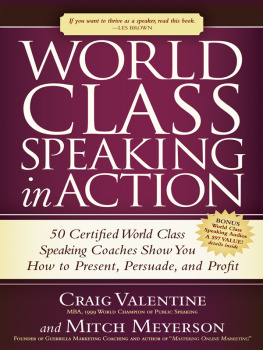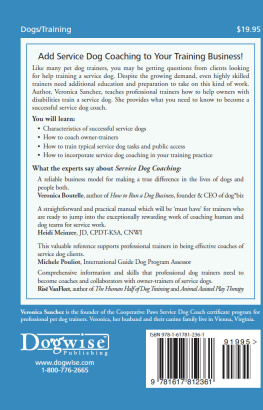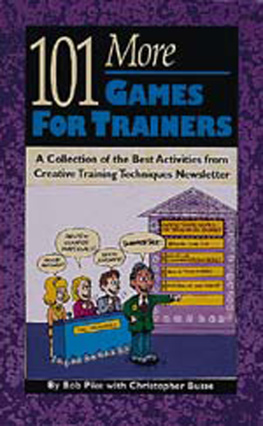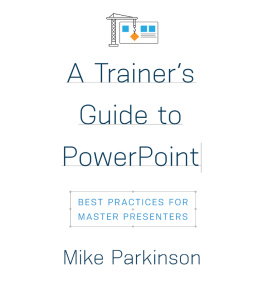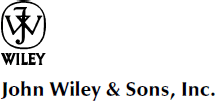
Table of Contents
- GIVING FEEDBACK WITHOUT
INTIMIDATING TRAINEES
List of Illustrations
- Chapter 1: Creating a Seminar Business
- Chapter 7: The Secret of Success: Selling Your Presentation
- Chapter 10: Using Visual Aids
- Chapter 11: Technology and Training
- Chapter 12: Giving Feedback and Coaching
Guide
Pages
HOW TO RUN SEMINARS AND WORKSHOPS
PRESENTATION SKILLS FOR CONSULTANTS, TRAINERS, AND TEACHERS
Third Edition
Robert L. Jolles
Copyright 1993, 2001, 2005 by Robert L. Jolles. All rights reserved.
Published by John Wiley & Sons, Inc., Hoboken, New Jersey.
Published simultaneously in Canada.
No part of this publication may be reproduced, stored in a retrieval system, or transmitted in any form or by any means, electronic, mechanical, photocopying, recording, scanning, or otherwise, except as permitted under Section 107 or 108 of the 1976 United States Copyright Act, without either the prior written permission of the Publisher, or authorization through payment of the appropriate per-copy fee to the Copyright Clearance Center, 222 Rosewood Drive, Danvers, MA 01923, (978) 750-8400, fax (978) 646-8600, or on the web at www.copyright.com. Requests to the Publisher for permission should be addressed to the Permissions Department, John Wiley & Sons, Inc., 111 River Street, Hoboken, NJ 07030, (201) 748-6011, fax (201) 748-6008, or online at http://www.wiley.com/go/permissions.
Limit of Liability/Disclaimer of Warranty: While the publisher and author have used their best efforts in preparing this book, they make no representations or warranties with respect to the accuracy or completeness of the contents of this book and specifically disclaim any implied warranties of merchantability or fitness for a particular purpose. No warranty may be created or extended by sales representatives or written sales materials. The advice and strategies contained herein may not be suitable for your situation. The publisher is not engaged in rendering professional services, and you should consult with a professional where appropriate. Neither the publisher nor author shall be liable for any loss of profit or other commercial damages, including but not limited to special, incidental, consequential, or other damages.
For general information on our other products and services please contact our Customer Care Department within the United States at (800) 762-2974, outside the United States at (317) 572-3993 or fax (317) 572-4002.
Designations used by companies to distinguish their products are often claimed by trademarks. In all instances where the author or publisher is aware of a claim, the product names appear in Initial Capital letters. Readers, however, should contact the appropriate companies for more complete information regarding trademarks and registration.
Wiley also publishes its books in a variety of electronic formats. Some content that appears in print may not be available in electronic books. For more information about Wiley products, visit our web site at www.Wiley.com.
Library of Congress Cataloging-in-Publication Data:
Jolles, Robert L., 1957
How to run seminars and workshops : presentation skills for consultants, trainers, and teachers / Robert L. Jolles.3rd ed.
p. cm.
Includes index.
ISBN-13 978-0-471-71587-0 (pbk.)
ISBN-10 0-471-71587-5 (pbk.)
1. SeminarsHandbooks, manuals, etc. 2. Workshops (Adult education)Handbooks, manuals, etc. 3. MeetingsHandbooks, manuals, etc. I. Title.
AS6.J65 2005
658.456dc22
2004059801
This book is dedicated to my wife Ronni who supported, assisted, and endured the trials of this project; to the thousands of trainees who allowed a struggling trainer to learn his trade and ultimately learn his lessons in humility and compassion; and to the memory of my dear friend Tony Fox.
PREFACE
Welcome to the world of seminars and workshops. Whether you are a trainer, seminar leader, guest speaker, or just someone who occasionally must deliver an idea by addressing a group of people, this book was created for you. From marketing and preparation to all aspects of delivery, this book will guide you through the many nuances that will allow you to direct a group of strangers so that they come together as a team and accomplish a common goal.
There are many misunderstandings surrounding the training profession. I hope to answer many of those questions. There are many opinions regarding right and wrong. As a trainer, I hope to give you definitive answers based on my experiences. As with any class I teach, I hope you find the book both informative and fun. I hope also that you will find support and motivation within these pages. That is one of the true values of a good Train-The-Trainer and that is what this book is about.
After I had finished school at the University of Maryland, my first job was for the New York Life Insurance Company. In four days, I was taught how to be an insurance salesman. I was taught the difference between term and whole life insurance. I was taught about preexisting conditions and other key areas of health insurance. I was even taught about disability insurance and the curse of the living death. Very scary! Four days later, when they were all through teaching me about insurance, I was shown the door and told, Two apps a week, ten apps a month. Go get em, tiger! I was trained. My training failed me. I was taught about my product, but no one ever told me how to sell it.
Most people who become trainers or presenters fall into the same trap. They are taught what to teach, but rarely how to teach it. They appear in front of their trainees as ill prepared as I was initially selling insurance. Customers want more than product knowledge, and so do trainees. There lies the importance of having information on not just what to teach, but how to teach it.
I have been teaching presentation programs for 25 years. Twenty-five years of active stand-up delivery training is kind of like dog years; that is, about 91 years of Train-The-Trainer to you and me! I have delivered these courses while employed by three major corporations as well as for myself as an entrepreneur. In those years, I have developed a lovehate relationship with a topic that I find fascinating. The love portion of Train-The-Trainer is connected to seeing thousands of presenters just like megroping for new methods, validating and replacing old ideas, and sometimes just hanging around to get their batteries recharged. The hate portion of Train-The-Trainer centers around its unforgiving nature. In just about any seminar taught, it is more than acceptable to misplace an overhead, forget a trainees name, or even lose your train of thought. When teaching someone How it is done, there is very little forgiveness for errors. It is a challenge. It will also age you a bit.
I view this book, as I do a good Train-The-Trainer, as a kind of vitamin. When you take a vitamin, your body uses what it needs and only absorbs what it can use. In this book, my intention is to give you too many ideas. Each may be appropriate depending on your topic, seminar size, personality, style, and any number of other factors. Take what you need and disregard what you do not find acceptable to your situation.
You will be reading and relating to real world situations and solutions. Let me give you a quick taste of real world in the life of a presenter. Recently I was asked to speak in front of about 100 managers for one of the largest insurance companies in the country. This presentation was set to last for six hours. The individual who coordinated the presentation on behalf of the insurance company had come to me only weeks before the presentation date telling me the presentation was no big deal, and to just walk the group through some simple sales skills. Well, as a professional trainer, I have learned that
Next page

